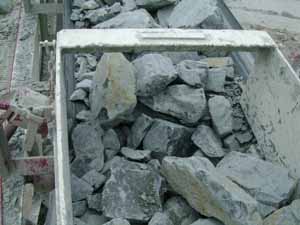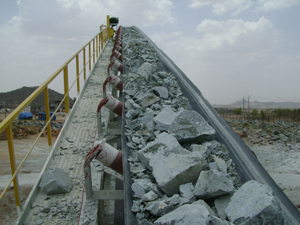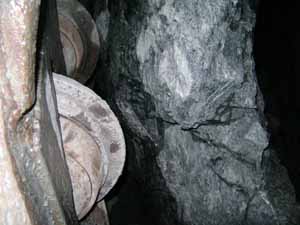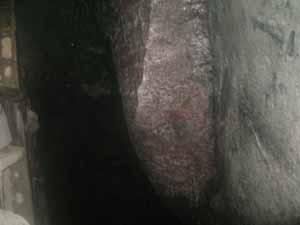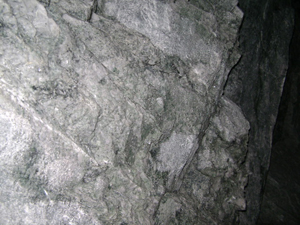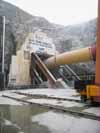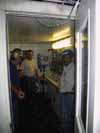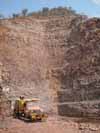
-
Get the Flash Player to see this video.
- Case Studies
advantages at AMR Jan 2009
Shani Wallis, Editor
-
India’s need for the advantages of TBM excavation is immense. Not for the labour saving benefits but for the speed and quality of construction by which TBMs can excavate long tunnels for hydro, irrigation, road and rail tunnels. India’s history with large scale TBM tunnelling however is limited and disastrous. The sorry saga of TBM drives for the Dulhasti and Parbati hydro schemes is recalled with much frustration by Indian engineers. Resorting India’s appreciation and confidence in large scale TBM tunnelling is a tough assignment and one that Robbins has accepted in full measure, starting with the AMR project in the state of Andhra Pradesh where it is working with lead India construction company Jaiprakash to ensure success of the longest, largest diameter, hard rock TBM tunnel in India’s history and claimed by Robbins as the longest in the world without intermediate access points. TunnelTalk visited the project to bring this report.
- “We are here to make sure this happens,” said John McNally, Project Manager on the AMR job site for The Robbins Company. “We have the first TBM now more than 1,900m into its drive from the downstream portal [early January 2008] and the twin TBM at the inlet portal is to start assembly in May.”
-

Fig 1. AMR project plan
- McNally is speaking of the 43.5km (27 mile), 10m (32.8ft) o.d. hard rock tunnel being excavated as the main element of an extensive network of tunnels and open canals on the Alimineti Madhava Reddy (AMR) Project that will feed irrigation and potable water by gravity to a vast drought-prone area of farmland and villages in the central state of Andhra Pradesh(1). The long tunnel has been under study for several decades and passes from the upstream Srisailem reservoir on the Krishn balancing pond near Devarakonda on the Dindi River (Fig 1).
- The long straight tunnel under the maximum 500m cover is needed first to avoid any pumping in the gravity feed system, and secondly to protect the natural environment. The tunnel passes under the Nagarjuna Sagar Tiger Reserve, the largest sanctuary for Bengal Tigers in India.
- The large contract of India Rupees 1,925 crores or about US $400 million includes several miles of open canal work as well as a second 7.25km long drill+blast tunnel on the alignment and is in the hands of Jaiprakash, one of the five largest commercial and construction conglomerates in India. Jaiprakash has extensive experience in civil construction and drill+blast tunnelling, but little in the field of TBM tunnelling. When planning its approach for the long, large diameter tunnel, with no intermediate adits permitted, a TBM operation was self-selecting, but Jaiprakash needed more than a TBM supplier; it needed a partner to bring expertise and technological knowhow.
- Extensive negotiations with The Robbins Company culminated in the signing of the largest TBM supply order in history. At a total of more than $US125 million, Robbins has three project contracts; one to supply two 10m diameter double-shielded gripper TBMs, a continuous conveyor muck haulage system for both, plus spare parts and cutters from the US; another to supply backup structures and other components from local Indian suppliers through Robbins India; and a third to supply, through Robbins India, a team of key personnel to manage the TBM boring process.
-

OFTA assembly of the 10m TBM
- More than this, Robbins has committed itself to a stake in completing the TBM tunnel within the overall contract period. The 60-month construction period is penalty driven to be completed in 2011. “Signing such a big order and committing financially to the success of the tunnel drive is something we at Robbins felt was important to establish confidence in TBM boring in India,” said Lok Home, President and owner of The Robbins Company. “Our exposure to the penalty risk is capped at 10% of the contract price and we mitigate this risk by not taking responsibility for delay events beyond our control.”
- In negotiating the contract, Robbins promoted the company’s OFTA – onsite first time assembly – strategy, which builds the machine in the launch pad at site and from preassembled components delivered from workshops and factories. The system was first used for the 14.4m diameter gripper machine on the Niagara water diversion tunnel in Ontario, Canada, and is proven to save weeks, if not months, on TBM delivery to launch-ready status. The considerable associated cost savings are shared by the contractor and the machine manufacturer.
-

Robbins site assembly team
- The landmark TBM order for the AMR project was signed in May 2006 and components for the first 10m machine began arriving in late 2007. In the meantime Jaiprakash had excavated the 40m deep x 160m long TBM assembly and launch portal. The deep vertical walls of the drill+blast excavation, with hardly a rockbolt to be seen and no shotcrete at all over the protective mesh, foretold of the hard rock conditions to be met in the drive.
- As with the Niagara TBM, OFTA of the first AMR TBM at the downstream outlet went “relatively smoothly”, according to Jaiprakash Project Manager, Anil Kamat. “There were some minor mismatch problems,” he said, “but these were worked out”, and by March 2008, some 16 weeks after delivery of the first components, the TBM and its continuous conveyor system was ready for launch.
- In the meantime, production of the segmental lining in a set of moulds supplied by CBE of France had started and a sufficient stockpile of the six segments and key in each 1.6m wide ring was on hand. Robert Wagstaff of Lancing Precast Management Ltd in the UK was engaged as a consultant by Jaiprakash to advise on design of the concrete mix and set up of the casting yard. All excavated rock is being recycled into production of the lining segments.
-

Segmentally lined tunnel
-
Geology
Hard quartzite bands of up to 450MPa (65,000psi) UCS layered and separated by shale is the predicted geology for about 50% of the long drive, with the remainder comprising granite of 160-190MPa (23-28,000psi). Each ring of 300mm thick segments, to an i.d. of 9.2m, is built in the tail skin of the double-shielded machine, allowing ring build concurrent with excavation, the lateral grippers applying force against the tunnel walls to counteract the forward thrust of the cutterhead rams. The invert segment of the lining is installed directly against the rock in the partial tail shield and the others are lifted and placed using a vacuum segment erector. - The need for a lining throughout the hard rock tunnel was explained by Bill Brundan, a Project Manager in India representing Robbins and advising Jaiprakash on the AMR project design. “The contract required a permanent lining to meet hydraulic design specifications and also to provide immediate support in reaches of potentially poor rock. Good quality rock cannot be guaranteed through the long drive particularly for about two thirds of the tunnel from the upstream inlet portal where horizontal blocky layers of quartzite and weak shales would have been difficult to support. Consideration was given to using an open gripper machine with a subsequent continuous concrete lining but this was rejected for logistical and programming reasons. A subsequent lining operation could not have been completed within the construction period and in reaches of low cover and in expected shear and fault zones, rockbolts and mesh would have been a time consuming support cycle. The prospect of needing large amounts of immediate shotcrete from off the TBM backup also led Jaiprakash to adopt a one-pass segmental lining throughout with the 100mm annulus backfilled with pea gravel and subsequent grouting.”
- To attack the hard rock, the 10m-diameter cutterhead is dressed with 67 front- or back-loading cutters with 20in rings on 19in hubs. The 20in discs provide for a longer wear life as well as application of higher cutters loads of up to 32 tonne/cutter. Specially designed drive motors allow the cutterhead to run at a higher than normal revolution to compensate for anticipated low penetration rates and in the event of bad ground, the cutterhead is capable of vertical movement to allow overboring by up to 100mm outside the shield diameter.
- Ground water inflows of varying quantities were predicted along the drive and each TBM is fitted with a 360° rotating drill rig that can be used for forward probing as well as drilling pre-excavation grouting arrays. Weep holes through the segments will relieve any water pressure build up behind the lining.
- The TBMs are also fitted with a more advanced real-time data logging system that monitors a greater number of TBM parameters, from hydraulic oil pressures and temperatures, to cutterhead motor amperage, cutterhead power, and gripper cylinder pressure. All vital parameters to control on these long 20km+ TBM drives. Robbins goals
- The vacuum segment erector supports a ring build cycle of about 30 minutes.
- Start of the TBM however was start of a steep learning curve. As well as up to 100 workers provided by Jaiprakash to each tunnelling shift, Robbins has a team of 53 directly employed staff – 13 experienced TBM expatriates and 40 locals including office staff, managers and shop mechanics.
- “The learning curve has been steep,” said McNally. “This is a big machine to manage and its continuous conveyor, vacuum segment erector and segment delivery systems have taken time to master.” In addition, crews have had to battle conditions beyond their control.
- One of the most critical is supply of electricity. The TBM is powered from the 33kV national electricity grid and transformed on the TBM backup to run the machine’s 22kV/690V/400V electrical systems.
- Unfortunately, reliability of supply has been a major problem through the first nine months of the drive. Electricity blackouts and drops in voltage have caused regular trips and abrupt shutdowns of the TBM. “At worst we have had 45 power cuts in a week and as many as 15 in a single day,” said McNally. There is a diesel generator station on the site but this is not used for long-term power supply. It is fired up in emergencies and to compensate for power cuts. When the grid is restored the expensive diesel generators are shut down.
- As well as causing potential damage to the TBM systems, the cuts play havoc with the operating routine. Not only do they shut down the TBM without warning, the continuous conveyor, powered also by electrical VFD motors, stops in its tracks. TunnelTalk experience one of these power cuts while visiting the TBM in October. The machine had just started its next stroke and the cutterhead was reaching optimum rotation when a power cut plunged everyone and everything into silent darkness. Restoration of the lights and power feed was achieved in about 5 minutes when the diesel generators kicked in.
Following a grand celebration in March 2008, the first TBM began its long journey towards an in-tunnel junction with its TBM twin advancing from the opposite inlet portal. The Robbins contract with Jaiprakash is based on achieving 400-500m/month for each TBM to have the 43.5km long TBM tunnel completed in a planned 50 months. The double-shielded TBMs, their support systems, and the production schedule of three 10h overlapping shifts/day, six days/week for start of the first TBM, are all geared towards meeting this contract obligation. The continuous conveyor extends from a 500m cassette and travels at 3m/sec for a haulage rate of 800-900 tonne/h. The cutterhead is rotated by 12, 315kW VFD (variable frequency drive) motors and propelled by a maximum forward thrust of 21,000kN. The vacuum segment erector supports a ring build cycle of about 30 minutes.
- The seriousness of the unreliable electricity supply is emphasized when remembered that the TBM is only at the start of perhaps a further 25km or more before it junctions with the TBM from the other end. When the issue was raised with the senior Jaiprakash manager on site, the response was that power cuts only last about five minutes until the emergency generators come on-line. This ignored the adverse affects of the cuts on the entire operation. Even through the learning curve, “training the workers to operate the machine requires consistence,” said McNally, “and we haven’t had that on several scores. Besides the frequent power cuts, we have also had to deal with adverse geological conditions and large water inflows.”
-
Boring conditions
While the large open cut at the portal illustrates the strong quality of the rock, it also forewarned of blocky conditions. The rock is blockier than anticipated and this did start causing immediate problems on the conveyors. The 20in cutters were said to be withstanding the conditions well with cutter use reportedly less than predicted, and extra grizzly bars across the cutterhead openings have helped reduce damage on the conveyors.
- Water ingress of up to 700lt/min through the face has also caused difficult conditions. When TunnelTalk was on the TBM, a ring build was in progress. At that time, the drive was in a particularly wet reach with water coming in through the cutterhead and gripper shield and over the ring build area. It was said that water ingress does not impair the effectiveness and safe operation of the vacuum segment erector but it was retarding the ring-build. Water was streaming across the segments in the invert pick-up zone, and flowing through and around the tail shield as workers bolted up the joints. Then the lights went out.
-
Conditions on the stacker conveyor
- Fortunately, the fail-safe system on the vacuum segment erector isn’t directly affected by the power cuts but the safety hazard of the black outs was clearly evident.
- The greatest impact of blocky rock and water ingress was on the conveyor system. From the face, the conveyor comprises four flights. The TBM conveyor discharges onto a transfer belt that crosses the backup and loads via a hopper, the long continuous conveyor. At the portal, muck transfers onto the stacking conveyor for discharging onto the stockpiles.
- Excessive water loading onto the belts creates major problems particularly on the TBM cross conveyor and into the hopper to the main conveyor. The cross conveyor is enclosed in a box cover but travelling water up and onto the start of the continuous conveyor is making working conditions tough.
-

Water ingress

Water on the continuous conveyor
- At the far end, it is the blocky nature of the rock that causes the trouble. “The heavy blocks bounce over the rollers and were rolling backwards down the inclined stacking conveyor,” explained McNally. Modifying this to a more gentle incline and creating a closed loading chute helped a more smooth transfer from the continuous belt.
- On the long horizontal conveyor, the sharp edges of the granite blocks have caused serious tears, the most extensive caused by a piece of rock jammed at a roller point that split the belt in half length wise. A full 1km length of belt had to be turned out and replaced.
-
Advance to date:
Despite the interruptions and delaying factors, the TBM had progressed a total 1,874.42m, or 1,162 rings, from launch in March to mid-December 2008. “When the TBM and all the supporting systems are running sweetly, we have recorded advance rates of up to 103m/week and our best day to date is 23.11m,” said McNally. - Also, although average availability of the system is disappointingly low - due largely to circumstances outside the control of the tunnel operating team - there have been good weeks. The weekly boring report for Week 40 for example shows a TBM utilisation of 41% and a 89.24m advance in the week’s 55.7h boring time.
- While the power cuts are a major safety and operating hazards, they accounted for 3% of total availability for Week 40 and amount to between 2% and 4% on average. “Avoiding the powers cuts would not add significantly to the overall advance rate,” said McNally, “but they really should not be part of the equation. They are a major interruption and have certainly extended the learning curve.”
- Eliminating these cuts over the long term and through the coming years of operation by the two TBMs was said to be an issue being addressed at project director level.
- Conveyor downtime in Week 40 accounted for 1% of availability and cutter changes for 14% (Fig 2).
-

Fig 2. Week 40 TBM statistics
- Since start of the drive, statistics show a positive trend, progressing per month through the learning curve from 40m to 100m, 220m, 280m, 300m and up to 360m for the month of November. “This is still low and we are well behind the average needed,” said McNally, “ and it didn’t help that we launched into a very hard dyke intrusion, but the machine, its support systems and, with time, the team will be able to achieve that once we get into a consistent, uninterrupted routine. Through the coming months we need to be achieving much higher monthly rates to reach the 450m/month as an average.”
- While visiting the outlet portal, McNally explained that Jaiprakash was busy with a major earth moving exercise at the inlet portal on the left bank of the Srisailam reservoir to create the assembly bay and operating site for the contract’s second TBM. From the main outlet site and its segment casting yard, it is a 1.5h journey to the inlet portal. Some parts of the second TBM are at the main portal site while other components are being delivered directly to the upstream site. “Making sure these components are unloaded and stored and protected properly is a concern,” said McNally. “We are hoping to take delivery of the portal site to start building the machine by 1st May next year and the second machine is now programmed for a launch on its downhill heading in about August next year.”
-
Contract partnering
By entering into agreements that involve greater responsibility for the outcome of the contract, Robbins is taking on considerable risk, but as Lok Home explained, “this is something that is increasingly being asked of machine manufacturers, especially in developing countries where the need is great and the domestic experience of TBM tunnelling limited. On-site-first-time-assembly of TBMs, especially for large mega machines, will become an industry-wide standard to take advantage of the significant time saving benefits. If application of TBMs in developing countries is to progress and a domestic base of knowledge and experience is to develop, TBM manufacturers will have to, in effect, make the technology transfer.”
-

Segment ring build area

Tunnel crown grouting
- Unfortunately, early joint ventures with international construction companies has not been a positive experience in India, with international partners supplying used machines that were not up to the task and abandoning the engagement when all goes horribly wrong, as has happened at Parbati where the used machine has been stranded in the flooded heading for more than a year. “This experience has to be reversed and if that means us partnering with the Indian main contractor to manage the TBM operation, that is a process we at Robbins are willing to negotiate and take on,” said Home. “We have entered various types of co-operative agreements beyond the standard cutter consumption contracts. These range from guaranteeing TBM availability to assuring negotiated progress rates as here at AMR. At the Olmos project in Peru, we are responsible for ensuring 85% availability and a minimum 2.5m/h minimum penetration for the 5.5m diameter gripper TBM in the 13km long headrace tunnel. Of course there is the risk of falling below the guarantees and assurances, and here at AMR, in the early days, we are not yet meeting the required progress rates, but in Peru we are getting 90%+ availability and up to 4m/h penetration – a very good result.”
- McNally came to the India as Project Manager for Robbins at AMR from the Peru project and is finding that there is a significant cultural difference between partnering in the two countries. “Here at AMR we are being considered more as a subcontractor than a partner but Jaiprakash is becoming more involved in the day-to-day tunnelling operation. There are other major works on the contract but the tunnel is by far the largest part of the total $US400 million value and Robbins is managing the TBM process according to a long schedule of agreements.”
- TunnelTalk was shown the large folder that holds the printed copy of the agreement that itemizes right down to supply of tools. “There have been some issues in translation and interpretation of the agreements,” said McNally. “For example does supply of ‘hand tools’ include supply of ‘powered hand tools’ such as power wrenches used for bolting up the segmental lining? Also, commitment to supply local workers to the tunnel and site management tasks at the portal has fallen short, in that workers with some experience are needed. To fill the experience gap we have had to employ more than the quota agreed in the schedule.”
- The main contractor is also responsible for a reliable power supply. “If we had been responsibly for power supply we would have priced to run the diesel generators full time to generate our own uninterrupted supply,” said McNally. On this point, all contractors working on contracts for the Delhi Metro and the its express airport rail link tunnels are generating their own electricity. This is not only preferred by the contractors, it is a contract requirement of the client, knowing that national grid supply in the city is overstretched and unreliable.
-

Tunnel intake site
- However, all new contracts are a new experience and with commitment, Robbins will see the long AMR tunnel through. In the meantime, the company has entered into similar supply and operation agreements for two further TBMs for major irrigation projects. The first is for the Pula Subbaiah Veligonda project on the left bank of the Srisailem reservoir where the new double shielded machine will excavate a 19.2km long tunnel to deliver water to the Prakasam, Nellore, and Kadapa districts of Andhra Pradesh. The machine has just started OFTA assembly for the HCC-Coastal Projects Pvt Ltd JV, for a projected launch in early 2009, and will work parallel to a 7.7m diameter Herrenknecht machine that is in the start-up phase of its 19.2km parallel drive for the NSL-SEW-Sabir-Coastal Projects Pvt. Ltd. JV.
- The second new machine, also 10m in diameter, is an EPB machine for the Slemmanabad carrier canal tunnel on the Bargi Diversion Project in Madhya Pradesh state near Juabulpur, about 800km northwest of Hyderabad. There, Coastal Projects has the contract to drive the 12km long x 9.2m i.d. segmentally lined tunnel within a 40-month contract period. The order was signed with Coastal in July 2008 and some financing issues need sorting ahead of project’s progress.
- With commitment by Robbins to these large-scale contracts, India is at the start of a new introduction to the advantages of large diameter, hard rock, long distance TBM tunnelling, at the same time taking advantage of the superior practical and mechanical experience of the world’s recognized leader in the hard rock TBM business.
References
-
1. Alimineti Madhava Reddy Project - Srisailam Left Bank Canal Tunnel Scheme (pdf download)
www.robbinstbm.com
Gallery
In response to the article, 'AMR India Project'
January, 2009
Maurice Gooderham, Retired, Formerly Director of Thyssen (GB) in the UK, Surrey, UK
“I read with interest the Srisailem article. In 1986 Thyssen GB was interested in the project with designers Howard Humpreys. The original documents noted that the tunnel route traverses "an area inhabited by wild and ferocious beasts”. I assume the risk of a survey team being eaten by tigers was avoided by the current availability and use of GPS.
Maurice Gooderham, Retired
Formerly Director of Thyssen (GB) in the UK
Surrey, UK
David Hindle, Tunnelling Engineer, Director, OTB Consultants, London, UK
“Believe it or not, this is the project that first got me working with Maurice Gooderham back in 1978. I was a grubby junior tunnelling engineer working for Howard Humpreys, fresh out of the mines of Africa and the burning deserts of Oman.
We got an enquiry from the Government of Andrah Pradesh to bid for the project in partnership with a suitable international tunnelling contractor. I ring Maurice and he suggested we should meet that very afternoon to discuss the options.
Howard Humpreys (now Jacobs Engineering) was based in Leatherhead, Surrey in England and the Thyssen’ offices were in Llanelli in Wales. It is a fair old way between the two and after starting at 11am and travelling on several connecting trains I arrived hot and bothered some time after 6pm, thinking I would be too late and they would have all gone home. Not a bit of it. I was ushered into Maurice’s grand office and money changed hands between Maurice and a colleague who had laid a bet on whether I would get there that day. "Never mind lad," said Maurice. "It’s not urgent we can talk about it tomorrow.” It marked the beginning of a beautiful friendship.
The Srisailem job died a death at that time and has been resurrected several times over the years - a bit like other major projects, including Crossrail in London, except that it is being built at last.
David Hindle, Tunnelling Engineer
Director, OTB Consultants
London, UK


